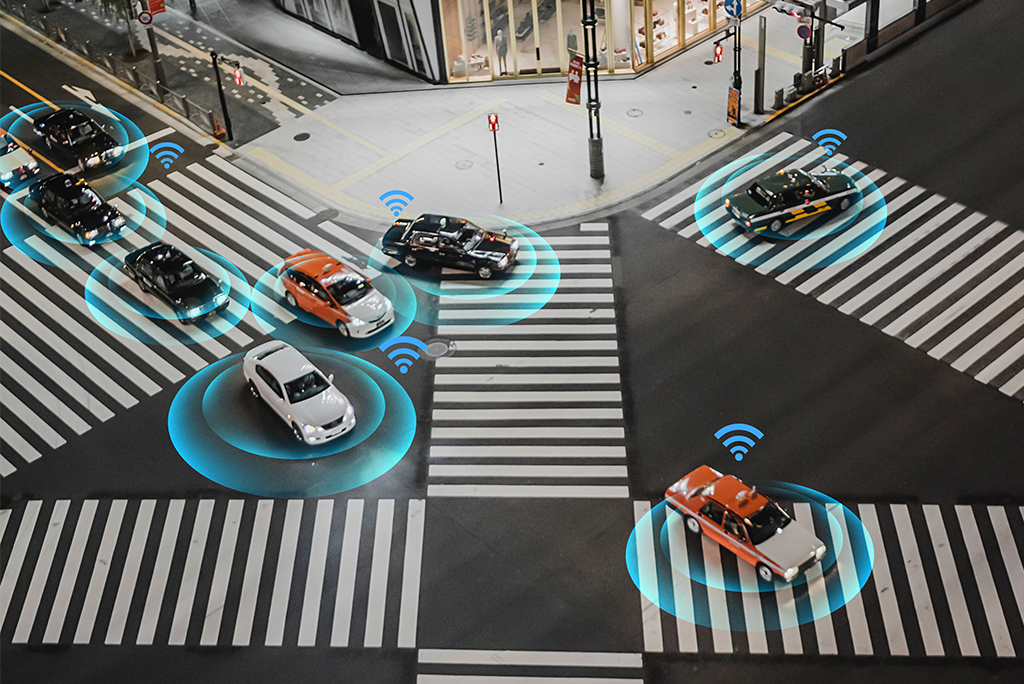
Autonomous vehicles have the potential to reduce traffic accidents. However, without proper security features that would protect them from hackers who seek to control them remotely—or from roadside vandals who might confuse them by damaging roadway infrastructure such as stop signs—autonomous vehicles could still pose threats.
With public safety in mind, many experts have called on governments to impose regulations on autonomous vehicle technology. Whereas the United Nations Economic Commission has begun taking steps to regulate cyber security for autonomous vehicles in 54 countries in Europe, the U.S. has yet to introduce specific regulations. However, the SELF DRIVE Act, U.S. legislation surrounding the safety and innovation in testing and deployment of autonomous vehicles, does require a cyber security policy from manufacturers on how they plan to respond to cyber attacks for vehicles that are highly automated.
Can Vehicle-to-Vehicle (V2V) Communications Systems Be Secure?
While governments determine cyber security standards for autonomous vehicles, engineers are hard at work developing technology that may protect these vehicles from potential threats.
Recently, a student research team from the Rochester Institute of Technology invented a prototype of vehicle-to-vehicle (V2V) communications equipped with software-defined radios that can send messages securely between vehicles.
“There are significant security problems that could actually make V2V-equipped vehicles more dangerous than current models,” Geoff Twardokus, one of the students involved in the prototype, told Rochester Institute of Technology (RIT) News. “For example, if there is no way to verify who is sending messages, what stops someone with bad intentions from abusing this technology to cause a collision, rather than avoid one?”
To develop the prototype, the team acquired a pair of programmable software-controlled devices known as Universal Software Radio Peripherals (USRPs), which they used to simulate two self-driving cars that could communicate with each other wirelessly. They also developed a graphical user interface (GUI) that allowed them to observe the V2V messages in real-time as the vehicles maneuvered along the road during the simulation. To ensure the messages were private, the team used IEEE 1609.2TM, a standard for securing V2V communications.
To verify the messages, the team applied an authentication technique that used digital signatures. Through cryptography, vehicles could verify incoming messages and mathematically confirm authenticity.
The prototype may represent the first reliable indication that IEEE 1609.2 can be used “in wireless communications in an open-source USRP-based testbed for research and evaluation,” Hanif Rahbari, an assistant professor in RIT’s Department of Computing Security, told RIT. “The industry is currently not convinced that 1609.2 and its supporting infrastructure are mature enough to be fully and reliably implemented on the road.”
When it comes to preventing collisions among autonomous vehicles, many experts consider V2V technology to be essential. While autonomous vehicle sensors act as the vehicles’ “eyes” by providing a limited ability to “see” the road, V2V offers the added ability for them to “talk” to each other so they can coordinate their movements.
“In addition to being safer on the road, people will further benefit when V2V technologies help make fully autonomous vehicles a reality instead of an ever-promised ‘coming soon’ attraction,” Twardokus told RIT. “It would also enable vehicle platooning, which refers to groups of autonomous vehicles operating as a single unit, rather than as individuals, allowing them to operate more efficiently and at higher speeds, resulting in significant reductions in gridlock.”
While only a prototype, the project demonstrates the possibility of equipping autonomous vehicles with V2V technology in a manner that’s secure.
Understand Autonomous Vehicle Technology
Prepare your organization for the latest developments in autonomous vehicle technology. Offer training in foundational and practical applications of autonomous, connected, and intelligent vehicle technologies. Developed by leading experts in the field—including Steve Vozar, CTO and co-founder of May Mobility—the IEEE Guide to Autonomous Vehicle Technology is a seven-course online training program.
Connect with an IEEE Content Specialist today to learn more about purchasing the program for your organization.
Interested in purchasing the program just for yourself? Access it through the IEEE Learning Network.
Resources
Bureau, Scott. (4 June 2020). Student researchers seek to improve cybersecurity of vehicle-to-vehicle communications. Rochester Institute of Technology News.


I wanna request to the engineering students and teachers that some of them should try to do research on the electricity generation with the help of plants. This type of technology is already invented in Germany, but now India has the chance to improve this technology.
Good Student Research
I appreciate the team’s innovation and hard work in developing a prototype that can enhance road safety by improving communication among vehicles. It’s amazing to see young minds making valuable contributions to the field of technology.